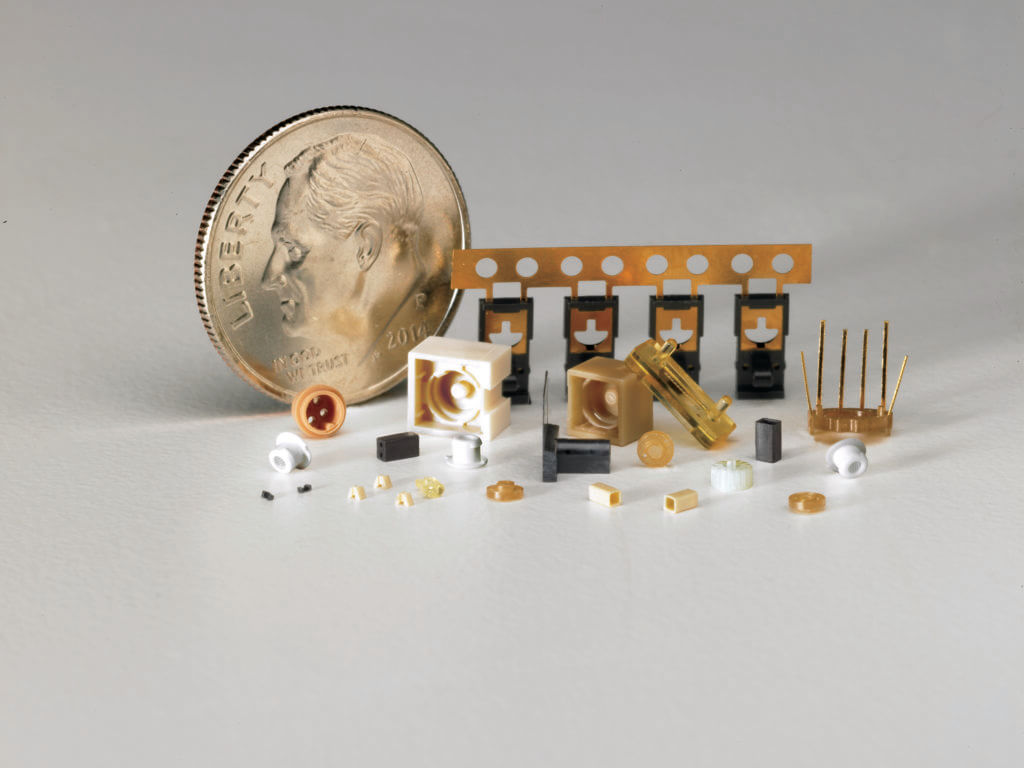Paul Runyan, VP Sales & Marketing, Accumold
In the precision-demanding realm of micro molding, the selection of appropriate materials is not merely a step in the manufacturing process, it’s the cornerstone upon which the performance and reliability of the final product rest. This article delves into the intricacies of material selection, highlighting how critical properties such as strength, flexibility, and thermal resistance shape the functionality of micro molded components, and positions Accumold as an expert in this meticulous selection process.
THE INTERPLAY OF MATERIAL STRENGTH AND MICRO COMPONENTS
When looking at micro molding, the imperative of strength in material selection cannot be overstated. Micro molded components are often required to bear significant mechanical loads, despite their diminutive size. This is particularly evident in the medical sector, where components like the tiny gears found in a medical pump must perform flawlessly under the pressures of constant operation. The materials used for such components must be chosen for their high tensile strength, a measure of a material’s resistance to being pulled apart, which ensures that the gears can transmit force and motion without succumbing to the stress of use. Failure to select a material with adequate tensile strength can lead to catastrophic component failure, resulting in device malfunction and potentially severe consequences in medical applications.
Expanding further on this point, the operational stresses that micro-sized components are subjected to can be both varied and intense. These stresses include dynamic loads that fluctuate with the device’s operational cycle, as well as static loads that are constantly applied. In addition to tensile strength, materials for such components must also exhibit adequate fatigue resistance, meaning they can withstand repeated stress cycles without failure. This becomes particularly critical in life-sustaining medical devices, where component reliability is not just a matter of performance but of patient safety. Therefore, engineers and material scientists must work collaboratively, often at the frontiers of material science, to identify and utilize materials that offer an optimal balance of strength and endurance. This ensures that micro molded parts will function as intended over their entire designed lifecycle, which can involve millions of operational cycles in some medical devices.
FLEXIBILITY — BENDING WITHOUT BREAKING
Flexibility in material properties plays a crucial role, particularly in applications where a certain degree of elasticity is indispensable. This characteristic is vital for ensuring that micro molded components can endure bending and flexing without losing integrity or breaking. For instance, micro-sized flex circuits, which are fundamental to the functioning of numerous portable electronics, must be manufactured from materials that retain their electrical properties even when bent or twisted. This kind of material malleability allows for the creation of devices that are not just functional but also durable and adaptable to the physical demands of daily use. Materials selected for such applications must, therefore, exhibit an excellent balance of pliability and strength, enabling them to bend without fracturing and maintain their structural integrity over time.
Consider the flex circuits in a folding smartphone, for example. These intricate components must withstand thousands of folds without any degradation in performance. The material for these circuits is not chosen solely for its initial flexibility, but also for its ability to maintain that flexibility over the product’s lifetime. Engineers must ensure that the materials can recover their shape and continue to function after each flex. This requires an in-depth understanding of the stress-strain relationship of potential materials and the resilience they can offer. Consequently, materials for these applications often include advanced polymers or composite materials that are specifically engineered to balance flexibility with the necessary tensile properties, ensuring longevity and reliability in the rapidly evolving world of portable electronics.
THERMAL RESISTANCE — ENDURANCE IN EXTREME TEMPERATURES
Thermal resistance is a critical factor in the selection of materials for micro molding, especially for parts that will face significant temperature variations throughout their operational life. This attribute is crucial for ensuring that the micro molded components can perform reliably under varying thermal conditions without experiencing physical or chemical degradation. For example, in automotive applications, electronics are frequently situated in close proximity to the engine, where temperatures can be exceedingly high. The materials used to create these micro molded parts must not only tolerate these elevated temperatures but also maintain their mechanical and electrical properties despite the heat. This necessitates materials with a high melting point and low thermal expansion coefficient to prevent warping, melting, or other forms of degradation that could impair functionality.
Further detailing the necessity for thermal resistance, consider the micro molded connectors and sensors located throughout an automobile. These components must consistently operate within a range of temperatures that can span from the extremely cold conditions of winter to the searing heat of a summer day, often in rapid succession. Materials with excellent thermal stability ensure that these critical components do not become brittle in cold temperatures or soften in the heat, which would severely impact their performance and reliability. It’s not just a matter of enduring the temperature extremes but doing so repeatedly over the lifespan of the vehicle without any loss of structural integrity or performance. Engineers and material scientists must therefore rigorously test and select materials that have been specifically designed or treated to resist such thermal challenges, ensuring the longevity and safety of the vehicle’s components.
THE ESSENCE OF MATERIAL SELECTION IN MICRO MOLDING
Micro molding represents a significant advancement in the field of precision engineering, one that has been instrumental in transforming the production landscape of small-scale components. This innovative technology is particularly critical in sectors where the miniaturization of parts is not just a convenience but a strict requirement, such as in medical devices and electronics. The materials chosen for these minute components are a critical factor in determining their final functionality and reliability.
The selection of the appropriate material in micro molding is not just a matter of matching specifications, it is a complex decision-making process that considers the intricate interplay of material properties and the expected performance of the component in its final application as we have seen. A slight miscalculation or oversight in material properties can lead to significant deviations in performance, potentially resulting in component failure under the high-stress conditions of real-world use.
For medical device applications, the material choice is further complicated by the need for biocompatibility and sterilizability. Materials must be carefully chosen not only for their mechanical properties but also for their ability to interact with the human body without causing adverse reactions. Furthermore, these materials must maintain their integrity after repeated sterilization cycles, which can involve exposure to harsh chemicals and high temperatures.
In the realm of electronics, micro molded components must adhere to stringent electrical standards. The material must insulate effectively or conduct electricity with precision, depending on its role within the electronic assembly. The miniaturization of electronic devices demands materials that can support complex circuitry in an incredibly compact space, while also dissipating heat and resisting the wear and tear associated with regular use.
Accumold, a leading innovator of the art of micro molding, is expert in navigating these complex material considerations. The company’s approach to material selection is grounded in a deep understanding of polymer science and a commitment to quality and precision. Accumold engages in extensive research and development to identify the materials that not only meet the required specifications but exceed them, ensuring that every micro molded component produced performs reliably under the most demanding conditions.
Accumold’s process begins with a comprehensive evaluation of the intended application of the micro molded part. It considers factors such as the mechanical load the part will bear, the environmental conditions it will be exposed to, and the longevity required by the application. This initial assessment is crucial in developing a material specification that is both precise and practical.
Following this evaluation, Accumold leverages its expertise in material science to explore a vast array of polymers and composites. Materials are assessed not only for their basic properties such as strength, flexibility, and thermal resistance but also for more nuanced characteristics like creep resistance, fatigue endurance, and moisture absorption. This meticulous attention to detail is what sets micro molding experts like Accumold apart in the industry.
Moreover, Accumold’s expertise extends to the customization of materials. Recognizing that off-the-shelf materials may not always provide the optimal performance for specialized applications, the company collaborates with material suppliers to develop custom formulations. This capability allows Accumold to fine-tune material properties to an unprecedented degree, creating bespoke solutions for its clients.
Quality control is another area where Accumold’s commitment to excellence is evident. Each potential material undergoes rigorous testing to ensure it meets the company’s high standards. These tests simulate the operational environment of the component, challenging the material’s mechanical, thermal, and chemical resistance. Only materials that pass these stringent tests are considered for use in production.
In the rapidly evolving sectors of medical devices and electronics, Accumold’s ability to anticipate and respond to emerging material needs has positioned it at the cutting edge of the micro molding field. The company’s ongoing investment in research and development ensures that it remains at the forefront, ready to tackle the challenges of new applications and technologies.
SUMMARY
The role of material selection in micro molding cannot be understated. It is a vital component of the manufacturing process that determines the success or failure of the final product. Through its extensive expertise and unwavering dedication to material science, Accumold has established itself as a leader in this field, delivering components that not only meet the demands of today’s precision-driven markets but also pave the way for future innovations.








